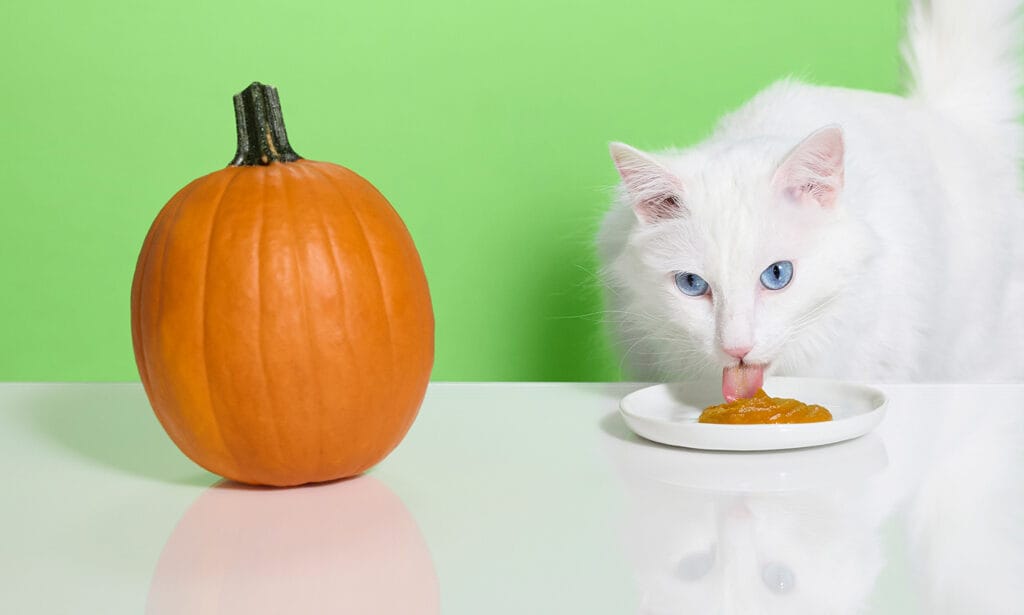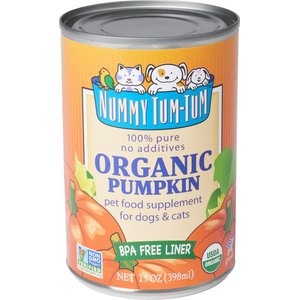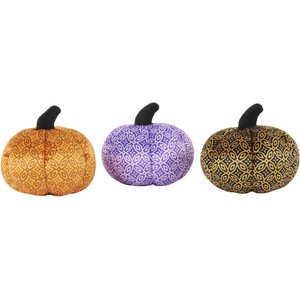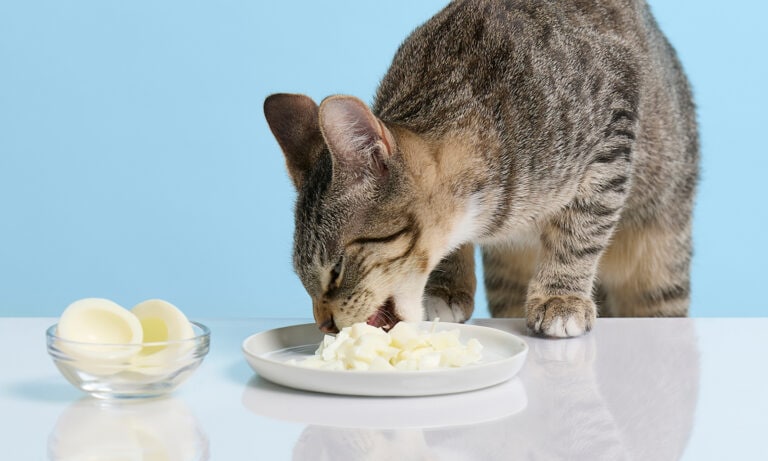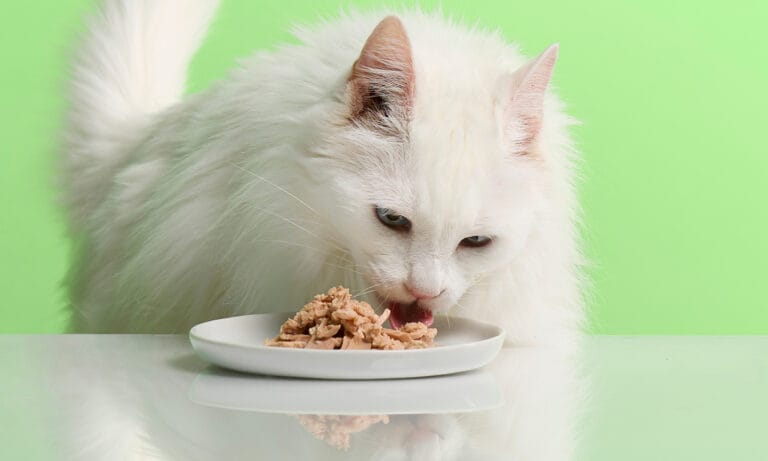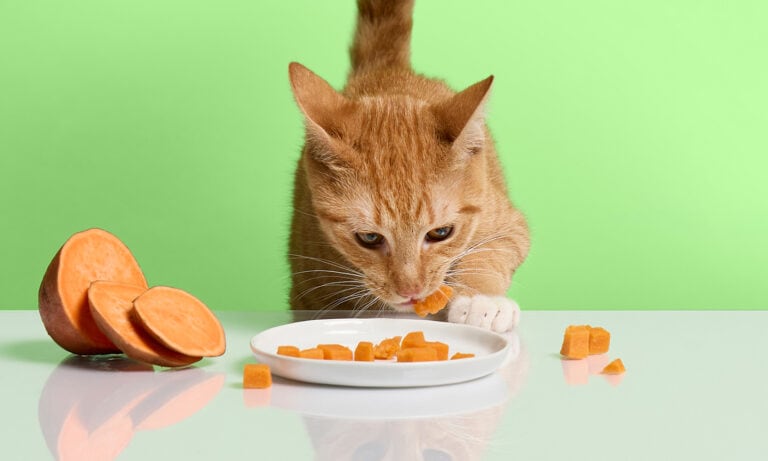Can Cats Eat Pumpkin?
Is Pumpkin Good for Cats?
The Health Benefits of Pumpkin for Cats
The Health Benefits of Pumpkin for Cats
The most widely known benefit of pumpkin for cats is to help treat digestive issues. If your cat has regular GI issues, you should consult your vet. But for the occasional abnormal stool or hairballs, pumpkin can be an effective treatment.
Here are all of the health benefits of pumpkin for cats:
- Helps relieve constipation: Pumpkins have a high water and fiber content and can act to hydrate the intestines and their contents when cats are suffering from constipation. The water and fibers will be absorbed by the dry stools in your cat’s intestines, and your kitty may experience relief as soon as a few hours.
- Helps prevent hairballs: This high-fiber content also makes pumpkin a great part of your cat’s routine to aid in hairball
- Helps alleviate diarrhea: Oddly enough, pumpkin can also be used to alleviate mild diarrhea. The soluble fiber in pumpkins actually helps absorb excess water in the bowels that the body didn’t absorb properly, thereby helping to calm diarrhea.
- It’s chock-full of nutrients, essential fatty acids and antioxidants: Pumpkin is also high in essential fatty acids and antioxidants (good for overall healthy skin and fur), and they are also an excellent source of vitamin A, beta-carotene, potassium, and iron and may even reduce the likelihood your cat will develop cancer. It is important to remember that while these vitamins and minerals are beneficial, if your cat eats a balanced diet, he or she should not be deficient in these requirements.
- Helps aid in weight loss: With obesity affecting a significant number of our cats, pumpkin is also useful as a supplement to aid in weight loss for your cat. Pumpkin adds bulk and will help keep your cat feeling full longer. If your cat is obese, contact your vet to get a personalized diet plan so your cat is not losing too much weight too rapidly, or too little weight too slowly.
How Much Pumpkin Is Safe for Cats?
Although pumpkin is a great addition to most cats’ diets, there is a limit to just about everything.
So, what’s the correct amount of pumpkin? No one knows the exact limit, but a recommended amount to start with is 1 teaspoon for adult cats or 1/2 teaspoon for smaller cats and kittens at each meal. The amount can be increased up to 4 teaspoons for larger adult cats.
“Just introduce slowly—and under the guidance of your vet,” says Dr. Rachel Barrack, veterinarian, certified veterinary acupuncturist, certified Chinese veterinary herbologist and owner of New York City-based veterinary practice Animal Acupuncture.
A warning sign you are overdoing the pumpkin supplementation is if the cat’s stools become orange, larger than usual and pudding-like in firmness. If loose stools do occur, skip the next supplementation of pumpkin.
Keep in mind that, unless otherwise directed from your vet, pumpkin should be given as a treat (yep, that means keep it to 10 percent of your cat’s daily caloric intake). Talk to your vet about your kitty’s daily calorie needs, or try this handy calorie calculator from the Pet Nutrition Alliance.
If your cat has a medical condition, such as diabetes, chronic kidney disease or suffers from dehydration, always talk to your vet first.
How to Feed Your Cat Pumpkin
There are a few simple do’s and don’ts to follow as a guideline for feeding pumpkin to cats. They include:
- Avoid jack-o’-lanterns: It is not safe to feed cats jack-o’-lanterns because raw pumpkin parts will go rancid very quickly. The leaves and stems are covered in sharp little hairs, which can irritate the mouth and gastrointestinal tract and cause tiny cuts in the cat’s intestines.
- Avoid pumpkin pie filling: The safest and simplest way to incorporate pumpkin into your feline’s diet is by using unsweetened, spiceless, pure canned pumpkin (not pumpkin pie filling), which you should be able to find in your grocery store. You can also try Nummy Tum-Tum’s 100% pure organic pumpkin for cats and dogs.
- Add to your cat’s wet food…: The pumpkin can be added directly to cat food, particularly wet food.
- …or straight from the spoon!: Many kitties enjoy the pumpkin flavor so much they are happy to lick pumpkin straight from the spoon, savoring it as a special cat treat.
- Start with small amounts: Remember to start slowly (1/2 teaspoon for smaller cats and 1 teaspoon for adult cats per meal) and adjust the amount as needed.
While many human foods are unsafe for our feline companions, pure pumpkin is a safe addition to your cat’s diet this fall season and year-round.
Cat-Friendly Recipe with Pumpkin
Got a pumpkin-loving purr baby? They’ll meow ‘til the sun comes down over these DIY pumpkin mini muffins.
They take just 15 minutes to bake and out pops this favorite fall feline treat.
Get the recipe! (Psst, we have even more pumpkin recipes here.)
FAQs About Cats and Pumpkin
Q:How much pumpkin can I give my cat if he has diarrhea?
A:“I consider pumpkin to be a gastrointestinal wonder food as it can be helpful with diarrhea by bulking up stool,” says Dr. Barrack. A good rule of thumb for an average-sized cat is 1 teaspoon once to twice a day, she says.
“Pumpkin can be used to alleviate minor loose stool,” agrees Dr. Sarah Wooten, DVM, CVJ based in Silverthorne, Colorado, “but keep it to just 1/2 a teaspoon for smaller cats or kittens.”
Dr. Barrack advises introducing it slowly, and under the guidance of your vet.
“The amount can be increased or decreased depending on effectiveness and your cat’s personal tolerance. Too much could push GI issues in the opposite direction,” she says.
Q:Can I give my cat pumpkin everyday?
A:As long as you don’t notice any problems and your cat likes it, feed away. Keep in mind that unless otherwise directed from your vet, pumpkin should be given as a treat (again, that means only 10 percent of your cat’s daily caloric intake). Your vet will know your kitty’s daily calorie needs, or you can try this handy calorie calculator from the Pet Nutrition Alliance.
Here are some important pointers:
- Daily pumpkin can certainly be helpful with pudgy pets, notes Dr. Barrack. “Pumpkin’s high fiber and moisture content lead to satiety which can be an effective component of weight management,” she notes.
- A couple of caveats (or “catveats” in catspeak): “Don’t feed them the skin or the pulp as the stringy stuff isn’t digestible to cats and avoid giving pumpkin to kittens 16 weeks and younger,” advises Dr. Wooten. “At that age, we just don’t know enough about their gut health. Their gut’s still growing so we want to allow for normal development.”
- And because pumpkin has both soluble and insoluble fiber, if a cat has any dietary issues, and needs more or less of a particular fiber type, it’s not necessarily a good daily choice, says Dr. Wooten.
As with any new food, it is important to consult your veterinarian before incorporating it into your cat’s routine. Before giving daily, determine the following:
- Is it beneficial to them? “How much would be best depends on your feline’s individual needs,” says Dr. Barrack.
- And, a word to the wise: If your fur baby’s stool becomes orange in color after imbibing, lay off the pumpkin. That’s a sure sign they’ve had quite enough of the orange stuff, thank you very much.
Q:Can cats eat pumpkin seeds?
A:They sure can. Dr. Wooten advises grinding up and sprinkling over their meal. Crushing them is best, she notes, since whole seeds might cause a choking hazard.
“Better safe than sorry”, she says.
Pumpkin seeds are fine to give raw, but your cat may like them toasted even more. And though you likely enjoy them tossed with sugar, spice and everything nice, that’s not a good idea for your feline friend. Keep kittie’s pumpkin seeds plain and simple, and of course, stop feeding them seeds if you notice problems.
Q:Can cats eat pumpkin puree?
A:Pureed pumpkin is the best and easiest way to incorporate pumpkin into your cat’s diet, says Dr. Barrack. Here’s the why and the how:
- “It’s most readily ingested and can be mixed with their regular food or given straight should they like it,” Dr. Barrack says.
- Adding it to their wet food is a great idea, Dr. Wooten adds. “It mixes really well that way.” And cats can be so picky, they may not want anything (not even scrumptious pumpkin puree) defiling their precious dry food.
If you’re buying canned pumpkin and doing the pureeing yourself, be sure to get plain canned pumpkin and not pumpkin pie filling, which will have sugars and spices not good for a kitty cat.
Q:Can cats eat pumpkin pie?
A:Sorry sweet-toothed cats, but no. Never feed your cat pumpkin pie or pumpkin pie filling, which generally contains spices, sugars and fat—ingredients that are much too rich for their systems, says Dr. Barrack. Plus, some pie fillings have nutmeg, points out Dr. Wooten, which in high doses can be toxic. In a nutshell, (pumpkin shell, if we’re going to be literal) save that extra slice of pie for yourself. You deserve it!
What Else Can Cats Eat?
Share:
